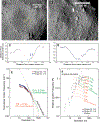The geomorphology, color, and thermal properties of Ryugu: Implications for parent-body processes
- PMID: 30890587
- PMCID: PMC7370239
- DOI: 10.1126/science.aaw0422
The geomorphology, color, and thermal properties of Ryugu: Implications for parent-body processes
Abstract
The near-Earth carbonaceous asteroid 162173 Ryugu is thought to have been produced from a parent body that contained water ice and organic molecules. The Hayabusa2 spacecraft has obtained global multicolor images of Ryugu. Geomorphological features present include a circum-equatorial ridge, east-west dichotomy, high boulder abundances across the entire surface, and impact craters. Age estimates from the craters indicate a resurfacing age of [Formula: see text] years for the top 1-meter layer. Ryugu is among the darkest known bodies in the Solar System. The high abundance and spectral properties of boulders are consistent with moderately dehydrated materials, analogous to thermally metamorphosed meteorites found on Earth. The general uniformity in color across Ryugu's surface supports partial dehydration due to internal heating of the asteroid's parent body.
Copyright © 2019, American Association for the Advancement of Science.
Figures








Comment in
-
Traveling to the origins of the Solar System.Science. 2019 Apr 19;364(6437):230-231. doi: 10.1126/science.aax3089. Epub 2019 Apr 18. Science. 2019. PMID: 31000648 No abstract available.
References
-
- O’Brien DP, Greenberg R, The collisional and dynamical evolution of the main-belt and NEA size distributions. Icarus 178, 179–212 (2005). doi: 10.1016/j.icarus.2005.04.001 - DOI
-
- Bottke WF Jr. et al., The fossilized size distribution of the main asteroid belt. Icarus 175, 111–140 (2005). doi: 10.1016/j.icarus.2004.10.026 - DOI
-
- Kameda S et al., Preflight calibration test results for optical navigation camera telescope (ONC-T) onboard the Hayabusa2 spacecraft. Space Sci. Rev 208, 17–31 (2017). doi: 10.1007/s11214-015-0227-y - DOI
-
- Suzuk Hi et al., Initial inflight calibration for Hayabusa2 optical navigation camera (ONC) for science observations of asteroid Ryugu. Icarus 300, 341–359 (2018). doi: 10.1016/j.icarus.2017.09.011 - DOI
-
- Tatsumi E et al., Updated inflight calibration of Hayabusa2’s Optical Navigation Camera (ONC) for scientific observations during the cruise phase. Icarus 325, 153–195 (2019). doi: 10.1016/j.icarus.2019.01.015 - DOI
Publication types
Grants and funding
LinkOut - more resources
Full Text Sources

